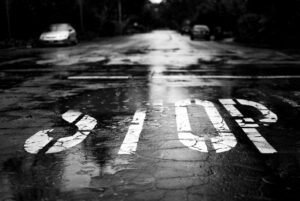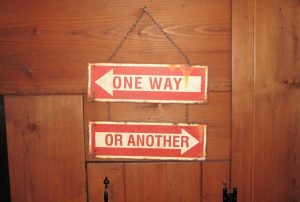Posts by Julianna Baggott
Credit: ABC Studios
My fellow writers, we need to talk about the new documentary by Andrew McCarthy, BRATS. It’s not just a nostalgia trip. It’s about criticism and rejection and survival as artists.
The film is instructive because it’s not about how criticism landed on one person and their career. It’s a research study about how criticism affected a group of people, each reacting in their own way. This is what gives us options.
(It’s also about a writer with his own bruised ego. We’ll get to him later.)
Here’s the back story — a group of young actors were enjoying huge success when, as NPR puts it, “journalist David Blum wrote a story in 1985 for New York magazine titled ‘Hollywood’s Brat Pack,’ centered on time spent partying with Estevez, Lowe and Nelson, that cast shade on the group — lumping them together as unprofessional and over-privileged, while sticking them with a moniker which would follow them all around for decades.”
We follow McCarthy as he tracks down as many members of the so-called Brat Pack as possible to find out, thirty years later, how the nickname affected them, professionally and personally.
What might be astonishing for non-artists is how heavily being lumped into that group weighed on McCarthy, disastrous to his career and to him, personally. But this is not an unusual story for creatives. I see storylines like this—albeit not usually at this level of fame—and openness.
Let’s take a beat to be grateful for McCarthy here. One issue facing creatives is that so few people are willing to talk about failure, real or perceived, so our narratives are skewed and our models for how to deal with rejection and failure go missing.
As we move through the film, we watch McCarthy realize that his reaction was specific to him, and not a foregone conclusion.
There’s a slider scale, one might say, of reactions here. Rob Lowe and Demi Moore on one side, having forged on. Emilio Estevez and Allie Sheedy are somewhere in the middle, having struggled with the name in their own way.
But it would be a mistake to see McCarthy as sitting on the other extreme. We don’t hear from Molly Ringwald. Judd Nelson remains elusive. Anthony Michael Hall is never even mentioned by name. It’s possible that the hardest hit aren’t visible to us on the slider scale and that McCarthy sits dead center.
Meaning, McCarthy’s response, though he seems doomed in retrospect, was actually pretty damn healthy. He’s thoughtful, introspective—sober, alive—and seems to have a full, happy life. But he can’t help but look back.
And, for all of the buzz around mindset, this is such a fascinating deep dive.
Demi Moore emerges as a brilliant gift. It’s Moore who quickly breaks it down for McCarthy. The nickname had value because he gave it value. It became what he feared it was.
In an earlier segment, while talking to Sheedy, McCarthy talked about how, in his auditions, everything felt different. With Moore, he talks about his fear, before the article, that someone was always going to stab him in the back. With Estevez, he hints at his troubled relationship with his father, with whom he could never make things right, but, in the end, […]
Read MoreWhen Emma Stone told director Yorgos Lanthimos that she was nervous about possibly winning an Oscar for her performance in Poor Things and having to give a speech, Yorgos said, “Take yourself out of it.” It comes at a time in our contemporary culture where so many of us are supposed to be cultivating a brand, engaging in self-promotional campaigns—not just around an event, but constantly racking up views and followers, as if we’re all jockeying for Biggest Cult Leader, and not coincidentally, anxiety rates are spiking.
We’re told, in so many ways, to put ourselves into it.
Yorgos’ advice is counter-cultural and, I believe, primal, and may be the smartest antidote to anxiety I’ve ever heard.
It’s also great writing advice—for creatives and entrepreneurs.
First of all, Emma Stone has talked about her relationship with anxiety openly. She panics. She even mentions panic in her Oscar speech, which is where she tells the story with Yorgos’ advice. From previous things she’s said, I take it that she realizes anxiety is powerful and instead of trying to erase it, she works with it. That’s also my take. I can’t make a team of horses disappear, but I can try to guide them in a direction. Fuel is fuel, even anxious fuel is precious.
But what does it mean to “take yourself out of it.” I’ve found that one of the best ways to feel less anxious—when I approach the page as a writer or touring or all the other stuff that comes with it—is to tell myself: Just be of use. Be helpful to someone else. In this way, I take the pressure off of myself to be someone and to perform. Instead, I’m there to help solve a greater problem. I’m there for the small moment when I connect with another human being. It’s no longer about me. It’s about others. That grounds me.
It also, I think, makes people want to work with me. I’m here to help. How can I help?
Does this sound like internalized sexism?
Because I think there’s a case to be made that, as a woman, I’ve absorbed the notion that my selfhood is more comfortable being erased and then replaced with something like servitude. And, raised Catholic, I always have to check myself against dogma and patriarchy. Last thing I want is to do the patriarchy’s work for them.
If I’m to absorb wisdom from the best life coaches out there, I should be stepping into my power, not hiding my light under a bushel, and shining—brightly and publicly—because in doing so I can inspire others.
Got it. Absolutely. I’m checking myself.
But at the same time, I’m also doing a gut-check, and self-promotion—which has been a big part of my job as a writer—still feels awful.
And what if that’s not just me or the patriarchy or sexism but something imprinted on my DNA? What if, hear me out, Look at me! feels awful because, on an evolutionary level, it separates you from the herd? And that separation makes you vulnerable and that vulnerability means you’re more likely to be killed.
Now, this is when, in my head, I cue Orna from Couples Therapy who wants to know about my childhood. I tell her it was a happy childhood. She leans […]
Read MoreWhen I said I was majoring in Creative Writing, it began.
“Do you know how hard it is to make a living as a writer?”
Then, when I said I was applying to graduate school programs, they said, “Do you know how hard it is to get into an MFA program?”
When I said I was trying to publish short stories, they said, “Do you know how hard it is to get published?”
When I said that I was working on a novel, they said, “Do you know how hard it is to write a novel?”
When I was pregnant and starting to have kids, they said, “Do you know how hard it is to write and have kids?”
This was all part of Phase I, though I didn’t yet know this beast even had phases.
When I had two kids and said I was publishing a novel—okay, here they were outright baffled. We moved into what I’ve come to call Phase II – which is: You seem to be saying you’ve experienced legitimate success and I’m confused.
“A novel that you’re publishing yourself?” they said.
“No, it’s coming out with Simon and Schuster.”
“But how did that happen?”
“I have a literary agent.”
This appeased them. Okay, someone else made this happen for me.
“Is it a children’s book?” they asked.
“No, it’s an adult literary novel.”
Then they circled back to Phase I and said, “Do you know how hard it is to get good reviews and have a bestseller these days?”
Let me be clear. These were accountants, teachers, lawyers, doctors, stay-at-home parents, chemists… People who did hard things to make a career and who knew absolutely nothing about publishing and yet, still felt free to—maybe even compelled to—explain things to me.
And, of course, when I mentioned that I was pitching ideas in LA for film and TV, they said, “Do you know how hard it is to get something picked up in LA?”
This incredibly consistent cultural effort to keep my hopes down—and therefore keep me in my place—continued on for a few decades. I published over twenty books, had four kids—my career kept going.
Fast-forward, I was recently at a small dinner party with friends and mentioned I had a new book coming out, a collection of mostly high-concept, literary short stories, intimately told, written with an eye primarily for film and television.
The man hosting the party seemed very interested. I explained what I enjoy—making a film or the beginning of a television show appear in someone’s mind as they read—and also explained my business model, that the stories go out to producers.
“And have you had any luck selling them?”
“Yes, we’ve sold many of them.” At this point, my spouse, Dave, and I were thinking about setting up a production company —“do you know how hard it is?”—which we now have done.
“And who have you sold these stories to?” the man asked.
I understood we’d moved into Phase II, and I needed to help him make sense of this.
“We have over twenty projects in development with some at places like Netflix, Paramount TV and feature…”
The conversation went on as he ate, saying very little. His spouse asked some questions, and I tried to explain […]
Read MoreI want to talk about a very specific kind of rejection from editors – the one about how they just didn’t connect with the main character or characters. It has variations, but basically they didn’t find the character likable or relatable enough or they didn’t fall in love with the character enough – not to the level they needed in order to make an offer.
I’ve been publishing for decades. I’ve had twenty-some novels published. This means that I’ve seen a lot of rejection. For every novel that found an editor, there was a stack of rejections. Plus, many of my friends are writers and I’ve taught writing for years so I also hear from my students with books that have gone out on submission.
And so, friends come to me after a few rejections of this kind and they’re often upended. They now believe that they wrote characters that are unlovable. They have to rewrite the book so that their characters deserve love or at least to be liked.
Of course the writers can’t help but take it personally. I don’t have to go on here about where characters come from.
Women writers often hear the message within the message and it’s not new to them. Be more likable. It can land as: Why don’t you have your characters smile more? Why can’t you smile more?
For writers who come from underrepresented communities, who are BIPOC or LGBTQ+, those who are writing about things like poverty or violence against women – this list could go on and on — the note that the editor doesn’t connect to the characters can land hard. It can seem that the publishing world is telling the writer that their experience is too foreign, too much from the edges. It can feel like being othered when often the entire novel exists in order to show – beautifully, painfully – what othering feels like.
I don’t think editors are mindful of this at all. This is a larger problem that I won’t tackle here. I believe this response is so pervasive that it is, to them, a clear and quick way – a nearly nondescript way – to pass on a novel. Often the rejection comes with compliments about the writing but they do little to help if the larger note is so disorienting.
It’s become an absolutely predictable part of the process of having a friend’s book go to editors, so much so that I have prepared speeches to talk them through this kind of rejection.
I mainly tell them that this response — not connecting with the main character — is as close to a form rejection as it gets. It is the “I’m so sorry I already have plans” of the publishing world.
It means nothing.
Read MoreAt the height of my obsession with the creative process as it relates to writing, I couldn’t find answers to all my questions so I decided to do my own research. Now, keep in mind, I know nothing about how to create actual data. I’m no researcher. This didn’t stop me. I put out a call to writers and surveyed one hundred of them, and the responses were fascinating to me.
The survey asked them to self-identify between a range of high- to low- producers. The first question began like this: On average over the last five years, how many pages have you written per year? (Generated, not polished and published)
When comparing answers from the two high-producer categories (a book-length work and more than a book-length work) with the lower-producer categories (under ¼ of a book-length work and ¼ to ½ book length work), the following results stood out.
When it came to the way one thinks about writing and flow, high producers seemed to have a more constant and ongoing processes:
Though the internet posed problems for both groups, the less productive group reported it was much more of an issue.
Both groups seemed about equal in reporting how often they were working to eliminate internet distractions from impacting their writing lives.
Both groups reported having trouble finding the mental space to work creatively if they didn’t have an extended amount of time they could rely on.
Overall, higher producers were less likely to report a struggle with concentration and finding themselves trying to get out of doing creative work because it’s taxing.
None of the above came as a surprise to me. My research and own experience were echoed in the results. But there were more questions, and some of them get a little weirder and more personal, sparked by my own curiosity.
When it came to psychology, I found that:
Read More
Sometimes I can physically remember what it was like, early on in my career – what it actually felt like in my body — to write in those early days. The wiring was just starting to stitch my mind to my hands to the page to the structure of a story to its characters’ inner worlds – and mainly how gawky I was. Writing as a tiptoe, then galumphing, how unsteady I was word-by-word, how much of it was an intellectual practice, so self-aware.
But even then, there were those moments when there was a tidal momentum that carried me from one word to the next and something was written without my full awareness. Those moments were addictive. I knew that they were essential. At first, it was words that sometimes took hold with their own momentum. Then I learned how voice could ground me in those moments and take over. And, finally, that flexibility was something I came to rely on.
There are still moments of what I call “making it up.” I talk to my students about this feeling, trying to put it into words. Of course, we’re always “making it up,” as writers of fiction – and too as poets and memoirists (as rebuilding memory and expressing it is an re-imaginative act). But I hate these moments when I feel myself writing. Sometimes they last just a few minutes until I find a way in to the work. Other times, the feeling endures – usually when there’s something new about what I’m writing, something I haven’t encountered before – it feels like I’m out of my depth, at sea. This is ultimately a good thing. I’m teaching myself something – new wiring is being formed.
I’m demanding about generating pages when teaching emerging writers – fiction, poetry, nonfiction and screenplays. The practice of writing pages helps you create pages, but also leads to those glorious moments when the work begins to write itself.
In sports – stay with me non-sports types, trust me – good coaches always make sure that their players have endurance because that conditioning is in their control. They can’t, for example, teach hunger for goals or ambition and drive. But like workshop leaders, they can help to create an atmosphere of taking risks and encouraging ambitious moves.
Can a good coach breakdown skill sets? Yes, and so can a good workshop leader – an exercise on dialogue, another solely on surface tension, another on subtext. But can they teach what’s perceived as athletic clairvoyance and split-second intuition? No. Those moments that seem like clairvoyance – on the playing field and on the page – you know what I mean, right? You’re writing without really thinking about writing. Split-second decisions are happening word by word and you’re not conscious of those thoughts. It’s as if your mind is fully wired to your fingers at the keyboard just as the athlete’s body is wired to the ball, the field of play, the defense…
How does this wiring happen? It’s not God-given alone for either the writer or the athlete. What you’re actually seeing as a fan or a reader is the result of hours drilled into a craft. This might seem obvious to many of you. But for […]
Read MoreI’m not sure that anyone should try to give advice about raising children. Much less about raising children while trying to write. Much less about raising children while trying to write and hold a job outside of writing. Much less about raising children while trying to write and hold a job outside of writing – while in quarantine.
But here you find yourself. And here I find myself. I have four kids. I had my first three kids during a five-year window. Then after a suspicious seven-year gap, I had a fourth. I published my first book when my third child was nine months old. I’ve gone on to publish twenty-some books, mostly novels.
Please read my tone correctly. I’m not saying this in some kind of chipper, look-at-me, cheerleader-y bullshit way.
My tone is grim. I’m writing this on Mother’s Day, in fact. My hair is unbrushed. I’m still in my bathrobe; it’s approaching lunchtime. The yard is weedy, the house disastrous. My thirteen-year-old daughter just walked in and said, “So when are we having a party?”
What? What party? Am I throwing a party in quarantine for my own Mother’s Day? “You’re thirty-four years old,” I told her. “You can throw a party yourself.”
She was confused because she’s clearly not thirty-four. I was confused. (Maybe this is a parenting tip? Sometimes, just don’t make sense. Throw them off. Occasionally, they just look at you and then walk away.)
How long have we been in quarantine? Shouldn’t she be thirty-four years old by now?
Before we proceed, I want to tell you what we’re going to do. We’re going to break down your writing process into parts. And then we’re going to break down your parenting into parts. And we’re then going to rebuild a process from there.
First, your process.
The main things I want to distinguish between for writerly parents are 1. Your writing time and 2. Your muse time.
Having kids is going to apply massive pressure on both. But people forget that there are distinct phases to writing. One you can do with kids around. The other is very very hard to do with kids around – at least for me.
So The Most Important Tip of All is to think about your process and break it down into parts. It’s possible that you used to do a lot of musing during your writing time. You’d sit down to write and begin by musing about it. Gazing out a window. Pacing around. Then moving back to the keyboard.
This might just be a luxury you no longer have.
Muse time can happen when you’re not at the desk. You can muse while living your chaotic life. You’re changing diapers, chopping food into non-choke-able sizes, washing, folding, rocking a kid to sleep, getting some rocks set up to be painted, sitting through some rehearsal/practice, shopping… and you can let your mind drift.
This mind drifting can be random and lack direction and just feel like daydreaming – or you can purposefully be aware of it and use it to think about your work.
[For a breakdown of how this muse-time process can be really active, I walk you through it here. [https://soundcloud.com/user-430267500/efficient-creativity-the-six-week-audio-series ]
I suggest a few things to go with this.
Read MoreThere’s this pervasive idea that the writer writes best in solitude – from Walden Pond to Salinger’s shed. And I’m sure there were a few of us writers – at least for a few indulgent moments – thought that self-isolation might be exactly what their work needed. It turns out that panic and deep fear and loss of wages and children suddenly not in school and being cut off or cooped up or desperately tending to others who are more vulnerable amid a pandemic is not the self-isolation we had in mind.
Can we still be creating in the time of quarantine? Some of us can’t, for many reasons. But if you’ve clicked on this piece, it’s likely that you’re someone who can.
If so, how? I don’t claim to have answers but here are a few thoughts.
1. Can you let the writing protect you? Try to carve out time and make it absolute. No bouncing back to the news. Keep your phone far away from you. Try to make the time at the page a world that you can step into – for a time, the only world that exists.
2. Don’t beat yourself up if this is hard. You should be rethinking your priorities; and it might be difficult — in light of all that’s going on — to prioritize your craft. The other day, I wrote a paragraph — that was it and not a hard paragraph — and I was pretty sure I deserved a parade.
Also if the work feels forced or faked or simply awful to make, remember that when this work is actually finished, no one (not even you, most likely) will remember whether you wrote it on a great writing day when everything felt organic, hitting full stride, or awful. The writing will exist and sometimes that’s all that you should ask of a first draft. It will have been rewritten — no matter how it was conceived. Sculptors begin with lump of clay. We have to sit down and make the lump. So do your future self a favor and create even when you’re faking it. (The first part of this – no one will know how you felt when writing it – might have come from Neil Gaiman, but for the life of me, I can’t find the quote.)
3. Creating something from nothing might be hard right now. If so, this could be a great time to give and take notes. If so, offer to read for people in exchange for getting read. This will also help combat the isolation of self-isolation. You could work on building those relationships with collaborative types, strengthen ties with other writers who might be feeling the same way. The ties you form now could be crucial and lasting – beyond the current crisis.
4. You also might want to form groups to keep up your accountability. These do not have to be writers. Anyone with goals will work – people trying to get fit, creating other art forms, learning a new language. My students have made charts where they check in and update their hours. A warning: For some people — type-As — this is too much. But in general, accountability research shows that it really […]
Read MoreIn 1987, Michael Graziano was a young neuroscientist. He and his team would study macaque monkeys to explore certain areas of the brain. The macaques were anesthetized, but the anesthesia leaked so, in their dark laboratory amid the chatter of firing neurons, he sometimes found himself hallucinating – the macaque getting up and moving but then after a double take, he realized the monkey hadn’t moved at all. He became a leader in the field of peripersonal neurons as it relates to the concept of personal space.
What does this have to do with writing? Nothing yet. So let me get to it. In a time when every experiment was laid out in advance – analyzed and mapped with clear succinct goals and contingencies, Graziano “…followed an extravagantly different playbook, an older style,” as he puts it in his book The Spaces Between Us. “I followed a two-stage cycle. First, go fishing. Second, take out the calipers and measure the fish.” He extends the metaphor. “In the first stage, we’d spend months exploring… Nothing was publishable… we’d keep our eyes open… filling notebooks… We’d pull out amazing fishes of bizarre shapes and colors that nobody had ever imagined before… When we stopped surprising ourselves every day, when we thought we knew what was going on, we’d shift to the second stage: measuring the fish in a formal, controlled manner.”
This resonated with my own process. I’ve taught workshops for a very long time, and, most recently, I’ve taught a lot of screenwriting. In screenwriting, it’s especially typical to write treatments, beat sheets, to work out the structure of the architecture, on a grand scale. A grand hypothetical scale or so it seems to me. What I’ve found is that sometimes the best work – that with the most grittiness and disorienting truth – often comes by accident, not planning.
In fact, early on in my workshops, my goal is often to have the students write well by accident – creating low-stakes, ambitiously risky opportunities for them to do just that. Once they write some scenes that have that charge to them, then I like to see their minds play out a larger structure for that scene to dwell inside of. Or as they come in with ideas to pitch to the group, I like to have them dig into a scene pretty early on – any scene – just to see how the characters mess with each other in a confined space. Often they can have a great idea, but can they write it, at this moment in their lives? Are these characters creating themselves or is the writer a puppeteer, telling them what to do?
As Graziano puts it, “If it hadn’t been for that two-stage approach… I would have elaborate theories, impressively complex experimental designs, well-trained monkeys pressing buttons and pulling levers, probably a whole stack of papers with enough technical showmanship to get into the most respected journals. But insight? Probably not so much.”
Yes, exactly.
So when it comes to the two camps of novelists – those who plan everything and those who write by the seat of their pants – I’d like to offer this other model.
Read MoreHeads up, WU’ers: Longtime WU contributor Julianna Baggott has created a new audio series for writers: Efficient Creativity: The Six-Week Audio Series. You can listen to the first episode for free, on SoundCloud.
—
A friend and fellow writer recently asked me how I keep multiple projects going at the same time. The answer didn’t come to me right away. In fact, I was stumped. But a few days later, I had three possible answers. For better or for worse, here they are.
1. Use frustration and burn-out to your advantage.
Over the last few years, I’ve become obsessed with creative process. At the height of that obsession, I ran a survey of over a hundred writers – self-identifying as high and low producers. One thing that the survey showed is that high producers – not stoned, by the way, just very productive producers – worked on multiple projects at once.
By this point, I’d already started working on multiple projects for a number of reasons. One of which, oddly enough, is that I realized I couldn’t push a project that wasn’t working; I had to have patience. Now patience doesn’t seem like the right answer in this case, but it was. Or another way to think of it: My frustration fueled other work. I wanted to leave the project alone – give it space – and I wanted to keep writing. So, I’d start something else.
At certain times in my career – not often – I’ve had whole days to write. When I do, I burn out after about two hours of work. But I learned that the burn-out was project-related. If I left it and went to something else, I could refuel.
Another hint – it helps if the projects are very different – different audiences, genres, tones… or, at least, that’s been the case for me.
I don’t know if frustration and project-related burn-out are why other high-producers work on more than one project at once or not, but I do know that working on multiple projects adds to their productivity.
2. Create physical manifestations of the projects.
One thing that novelists suffer is the lack of physical manifestations of their work-in-progress. Architects have blueprints – we have … spaces in our heads. People who map their projects ahead of time have an advantage here – their novel’s cartography is a kind of short hand.
But you don’t have to be a plotter to create physical manifestations of your work-in-progress. Create drawings, lists, maps of what you’ve done, not necessarily where you’re going. Try it. This will allow you to enter and exit your projects faster and help you move between projects more cleanly.
3. Rituals.
Read MoreHere’s a hard truth: Each novel teaches the writer how to write it. If you’re a parent, this might sound immediately, intuitively right. You can have a philosophy as a parent of one child but your second child can humble you very quickly. Smart parents know their children teach them how they need to be raised, each one individually.
So, when someone asks me – and it’s a common question – how many drafts I usually write of a novel, I know they’ve likely never written a novel and definitely haven’t written two of them.
Show me a cocky parent or a cocky writer who is steadfast in their one-size-fits-all philosophy on how to write a novel or raise a child and I’ll show you a liar – or a pack of miserable children and/or miserable novels.
Some novels that I’ve written have come out with their structure intact. The foundation is strong. Others need page-one rewrites. One novel took me 90 days to write and came out fairly whole. Another novel took me eighteen years. How many drafts do I usually write? There is no usual.
The most frustrating part, for me, is that I can’t tell which novel will come out relatively easily and which will be brutal.
Writing a first draft of something as architecturally massive as a novel – all that scaffolding, the stone arches, the delicate gargoyle work – is a real achievement. Don’t denigrate that. But as you become a serious novelist, accept that it’s just a first step, that the bulk of the labor will come during revisions.
When I was a new novelist, my work was quickly set in stone. It was hard to make edits. I didn’t have the mental space to hold a novel and turn it in my head. I couldn’t yet think of an edit and immediately – as if the novel were lit up on a CT scan – see the ripple effects of that edit brighten in my mind’s eye. Now I can raise and lower parts of the novel mentally. I see sequences. I can sense imbalance in point of view or structure the way, maybe, a composer knows the arrangement as an orchestral structure held aloft.
There are things that I know now about revision that I wish I’d known then. If you’re reading this because you’re stuck and you don’t know how to begin your revision process, here are a few ideas.
1. If you have another area of expertise, use the transferrable skills. To anyone who has worked in other fields in which there are complex structures that entailed stretching their brains to understand, know that there’s more common ground than you think.
For example, some soccer players can recall a game play-by-play. They can think in general pacing and overall tidal movements of the game. They can think in terms of act-structures – with a midpoint, aka halftime. They can home in on certain passing sequences which completely transfer to the movements of novel sequences and even then down to footwork – nutmegging a defender in the midfield, which can be thought of as the sentence.
Dear chemists, the scene is all about tension and release of tension, positive and negative energy; I could draw you a sketch […]
Read MoreThe other night, as a party of writerly types was winding down, I was caught up in a commercial versus literary discussion. Purity of purpose versus reaching out to readers. Aesthetics versus money. Art versus entertainment. Respect of the literati versus wide readership.
As a novelist who has published over twenty books, I’ve written both art and entertainment. I tend to know, when I first set out, the novel’s intentions. Truth be told, editors and readers often see things completely differently, as is their right. I’ve had a novel bought by a more commercial press only to be told that they see me as one of their literary writers. And I’ve had a novel bought by a more literary imprint who saw the book as one of their more commercial titles.
And so it may come as no surprise, I have a take on this age-old debate.
My bottom line is this: both are traps — the desire for readership and the desire for respect.
At the party, I had loud, obnoxious things to say about David Foster Wallace, having finally seen The End of the Tour. In the biopic, we see a novelist at the height of critical and commercial success expressing his deep fear of being perceived as a sell-out, as a prostitute, as he put it.
Now, my grandmother was raised in a house of prostitution; her mother was the madam of the house. And so this hit close to home. I doubt there’s anyone alive today whose very existence doesn’t, in some way, owe their existence to a woman in their lineage who was forced to have sex for money — through prostitution or being sold into a marriage or a marriage based on a transfer financial holdings, from queens to commoners.
My great grandmother started her house of prostitution during the Great Depression so her three children wouldn’t starve. As the sole breadwinner for a family of six, I’ve written certain books of mine with a very keen eye on market. (Others with no eye on market at all.) Wallace’s distaste for or more pointedly, perhaps, his fear of being perceived as a sell-out struck me, suddenly, like an enormously privileged posture.
But, don’t get me wrong, I don’t blame him; I never knew him. Instead I blame our weird culture that forces writers — and other artists — to choose between two extremes: the pure artist (sometimes called the starving artist) or the sell-out. It feels punitive, and, as soon as I cast my suspicious eye on our culture, these limited extremes feel really familiar to me as a woman. I’ve been here before.
Madonna or whore – and here we are back to prostitution. Or, as they put it in the Breakfast Club, a slut or a prude.
In retrospect, Wallace was struggling on many fronts and I can’t begin to imagine, and wouldn’t presume, the very serious mental health issues he was trying to work through. But I wish we could have erased these fears and just let the writer write.
To me, the snapshot of Wallace’s life that the film reveals is of a man who has fallen into trap of respect — art for art’s sake – and was held there so tightly that his fear of the commercial world that gets books to readers […]
Read MoreThis week I handed eighteen writers a list of skills – from dialogue to structure to imagery to ability to take criticism and resilience. The writers scored each of their perceived abilities on a scale of 1-10. They weren’t comparing themselves to literary giants, just their own limitations. [Click here to see the list and score yourself.]
Granted, it seems a bit cruel, forcing writers to be both a little cocky while having their weaknesses laid bare.
Here’s why I did it. As writers, the model for improvement is criticism on the page. But rarely is someone looking for overall weaknesses, rarer still is someone creating a plan to attack those weaknesses.
Couple this with moments of positive feedback. A note on beautiful setting or deep characterization and what happens? Well, too often, the positive swells in the writer’s mind. You like it when I write setting? I’ll double down on that. You think I’m good at deep characterization? The next story is all deep characterization.
We lean into what we’re good at and we avoid our weaknesses.
This doesn’t usually happen in other fields. If you’re a talented young soccer player – a leading scorer – but you can only strike with your right foot, you’ll find that, by the time you’re twelve, someone is drilling you on shooting with your left. If no one does, you’re not able to compete when the speed of play picks up in high school. It’s over pretty quickly.
We fear our weaknesses. I get it. But if you’re naturally fearful – most writers are – you might enjoy my take that fear is a good sign. It’s an indicator that you’re pushing the work beyond your capabilities, which is a sure way to stretch those capabilities.
But you shouldn’t be passively, vaguely fearful of your weaknesses; be aggressively, actively fearful. Know your weaknesses and attack them.
As an undergraduate, none of my stories had dialogue. I didn’t know how to write dialogue. I’d never been taught.
Problem solved: my characters wouldn’t talk.
I realized that this probably wouldn’t work, long-term. So I took a playwriting class where we wrote a one-act and a 75-page full-length play. I got over my fear and love writing dialogue.
I continued to look out for my own tells. If I’m writing lush language, it’s often a cover for the fact that I really don’t know what my characters want and fear in a scene. I go soft on my characters; I’m sweet on them. I’m weak when it comes to the passage of time, as well as spatial understanding of landscapes. I attack these issues in rewrites.
I’m always surprised when emerging writers tell me things they don’t do. “I don’t write in first person. It just doesn’t work for me.” My answer is, “Write exclusively in first person until you get to know it, intimately. What does offer? What does it deny you?”
And I’m also often stunned by the limitations that established writers place on themselves. There’s the idea of building a brand, I get it. But too often, it’s not about their audience, but who they are and what they fear.
Lean into fear.
I once thought up the most awful game ever. A group of published writers get together – writers who’ve followed […]
Read More




















